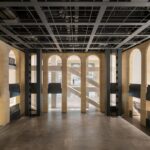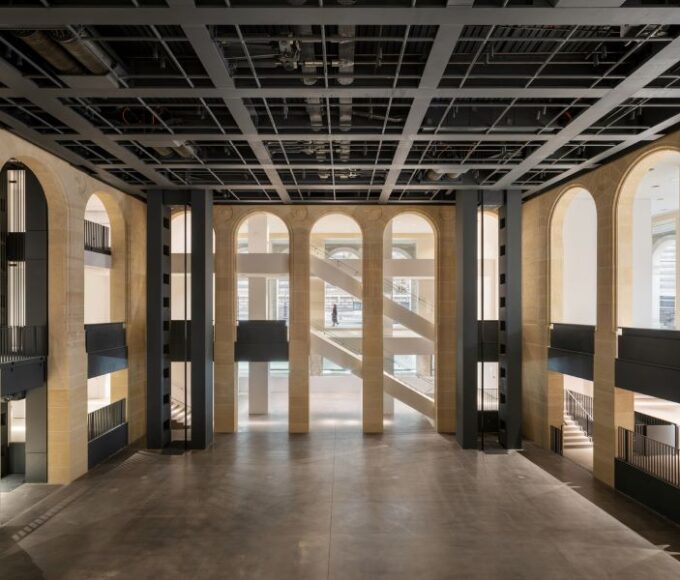Suffering a catastrophe in April 2019, Notre Dame de Paris reopened to the public after a long restoration of five and a half years. The world-famous cathedral will once again welcome visitors from around the globe with a renewed look.
On Nov. 29, French President Emmanuel Macron made his final site visit before the opening, which included the nave, choir and chapel. He was accompanied by the Archbishop of Paris, as well as the French Minister of Culture, the Mayor of Paris and other officials, and a number of French media outlets and international television stations broadcast live, thereby demonstrating the new face of Notre Dame de Paris. Macron said after the on-site inspection, “The grand celebration on December 7 and 8 will be as shocking as the fire, but this time it is a ‘shock of hope’.” He also mentioned that the deadline set for reconstruction was considered by some to be a “crazy” or “arbitrary” challenge, but that the goal has now been achieved. He thanked the nearly 2,000 restoration workers involved in the “Project of the Century”, some 1,300 of whom took part in the event. You are the alchemists of this project, transforming charred ruins into art,” he praised, adding, ”The Notre Dame fire was a national wound that you healed through your will, your work and your commitment. I am deeply grateful, and so is France. You have restored Notre Dame de Paris to its original state”.
The Accident That Befell Notre Dame de Paris
Notre Dame de Paris was built in the 12th century on the Île de la Cité in the middle of the Seine River, in the historic core of Paris, and is one of France’s most iconic monuments, known as “France’s National Treasure”. On April 15, 2019, Notre Dame de Paris burst into flames, with the iconic steeple collapsing and the roof caving in, but the two bell towers, which were the main structure, were saved. bell towers were saved. Paris police investigators believe the fire was accidental, with a short-circuit in the electrical wiring being one of the possible causes.
After the incident, both chambers of the French parliament passed a bill requiring reconstruction work to ensure that Notre Dame de Paris was restored to its original state. On April 15, 2020, the first anniversary of the fire damage to Notre Dame de Paris, French President Emmanuel Macron pledged to complete the restoration of Notre Dame de Paris within five years. After the fire, global donors, including French billionaires, provided more than 800 million euros for the restoration of Notre Dame de Paris, said Philippe Jost, head of the restoration project. In the end, about 2,000 masons, carpenters, restorers, roofers, foundry workers, art experts, sculptors and engineers were involved, and the restoration project as a whole cost nearly 700 million euros.

Notre Dame After Restoration
The restoration strictly followed the principle of “restoration as it was”, with the Gothic style preserved intact and the spire destroyed by the fire rebuilt according to the design of the famous 19th-century French architect Violet Le Duc, alongside a scroll listing the outstanding contributors to the restoration work. The interior walls, stained glass windows, vaults and decorations have been completely cleaned and restored to their former glory. In addition, more than 20 17th-18th century paintings in the church have been restored and are ready to be displayed to the public again. Notably, precious artifacts such as Jesus’ Crown of Thorns, which survived the fire, are now housed in newly designed cedar wood reliquaries for viewing.
The first thing that strikes you when you enter the restored Notre Dame de Paris is how bright and airy the interior spaces are. Rémi Frémont, chief architect of the historic monument, describes it: “All of a sudden, you step into a space that you thought was very dark and gloomy. Now you find an extremely bright Gothic church with very bright and clear stone colors. Whereas before the church was quite stained, now we see a church with a restored ‘golden sheen’.” The tour route follows the life of Jesus, along with restored paintings and sculptures, new bronze religious liturgical furniture (such as the baptistery, altar, pulpit, etc.) and 1,500 light-colored wooden chairs, which replaced the destroyed pews in a minimalist modern style, adding a touch of modernity to the space.
The reconstructed cathedral introduced modern safety features, including a fire alarm system, fire walls and sprinkler system. Among other things, reinforced water pipes can carry 600 cubic meters of water per hour, ensuring that the cathedral is better protected than ever before. In addition, Notre Dame de Paris will launch a perimeter renovation project in the fall of 2025 to further enhance the visitor experience by adding greenery as well as optimizing public spaces. The square’s underground parking lot will be transformed into an indoor promenade containing a bookstore, café, and entrance to the Archaeological Museum, providing visitors with convenient services and driving the tourism industry in France.
Notre Dame de Paris is planning an eight-day religious and cultural celebration from Dec. 7 to 15. On Dec. 7, Macron will deliver a speech in the church square, followed by a religious service and concert that will be attended by dignitaries from several countries, but the guest list has not yet been announced. The first Mass on Dec. 8 will bring together 150 bishops from around the world and will be open to the public that evening. A number of Masses will also be held during the week of celebration that follows, honoring donors, sponsors and neighborhood residents.
Reconstructed Notre Dame de Paris Attracts Large Numbers of Visitors
The reopened Notre Dame is expected to attract around 15 million visitors a year, and the French culture minister has proposed that visitors should be charged a “symbolic” entrance fee of 5 euros, which he said would be used to fund the preservation of France’s cultural heritage. Despite previous controversy over whether or not to charge an entrance fee, the church will remain open for free for the time being. In order to cope with the huge number of visitors after the opening, the church’s management will launch an online reservation system, which will allow visitors to choose a time slot for their visit in advance through the official website or mobile app, effectively reducing queuing time and ensuring smooth entry during the reservation time. Visitors who go directly offline can also visit, but face the possibility of long queues during peak hours.












